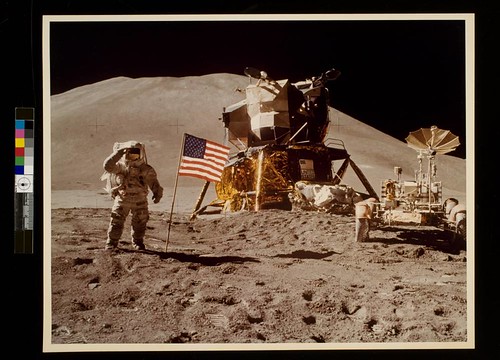| Share Presentation: https://NeoK12.com/pres/ZLUNAR03 | |
Earth's Moon
| The Moon is Earth's only natural satellite. It stays in constant rotation with Earth and always shows the same face, or side, to us. It is the brightest object in the Earth's sky after the Sun, but its surface is actually very dark. The light from the sun reflects off of its surface to make it 'shine.' What do the markings on the moon look like to you? Can you see a picture in them? What do you think those marks really are? | ||||
| When the Earth and the Moon orbit around the sun, it changes the amount of light that is reflected off of the Moon's surface. This makes it look like the moon changes shape in a regular pattern, called phases. Keep an eye out in the night sky, and consider making a moon journal. Draw pictures and write about what you see and what you think about the moon. Remember to put the DATE from the calendar on your pages! | ||||
| The Moon's size in the sky and its regular cycle of phases have made the Moon
important to people since ancient times. It has affected language,
calendars, art and mythology. Look at a calendar and find the moon phases in each month. Are they always on the same days? Look at the word MONDAY. It comes from the word MOON, but we do not say MOONDAY because the word changed over time. (What do you think the word SUNDAY comes from?) We even decide when to have some holidays by the phase of the moon. The Moon even affects how the ocean waves move! | ||||
| The Moon is the only astronomical object on which humans have landed.
The Soviet Union's landed the first spacecraft in 1959, but it was
unmanned. The United States' NASA Apollo program has landed people on the Moon 6 times between
1969 and 1972—the first being Apollo 11. Since 1972, the Moon has been
visited only by unmanned spacecraft. How long has it been since the man's first Moon landing? How long since the most recent landing? Why do you think they have not been back in so many years? Future manned missions to the moon have been planned both by governments and by private persons. The Moon is under an Outer Space Treaty, so it is free to all nations to explore for peaceful purposes. | ||||
| The moon does not have any life living on it. It is bumpy and rocky. It is very different from Earth. There is no air to breathe. There is no gravity to keep things touching the ground. It is not easy to visit the moon, and only a few people with special training can do it. What does it feel like to be in a space suit? How does it feel to go in a space shuttle? What is it like to bounce around on the moon? Could people one day live on the moon? Is that a good idea? Why, or why not? I wonder . . . | ||||
Share this Presentation: https://NeoK12.com/pres/ZLUNAR03 NeoK12.com - Educational Videos, Lessons, Quizzes & Presentations
NeoK12.com - Educational Videos, Lessons, Quizzes & Presentations
All images are linked from Flickr Creative Commons under CC BY, CC BY-SA, CC0. Click attribution link under image for full details.




